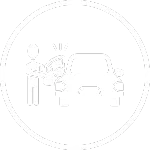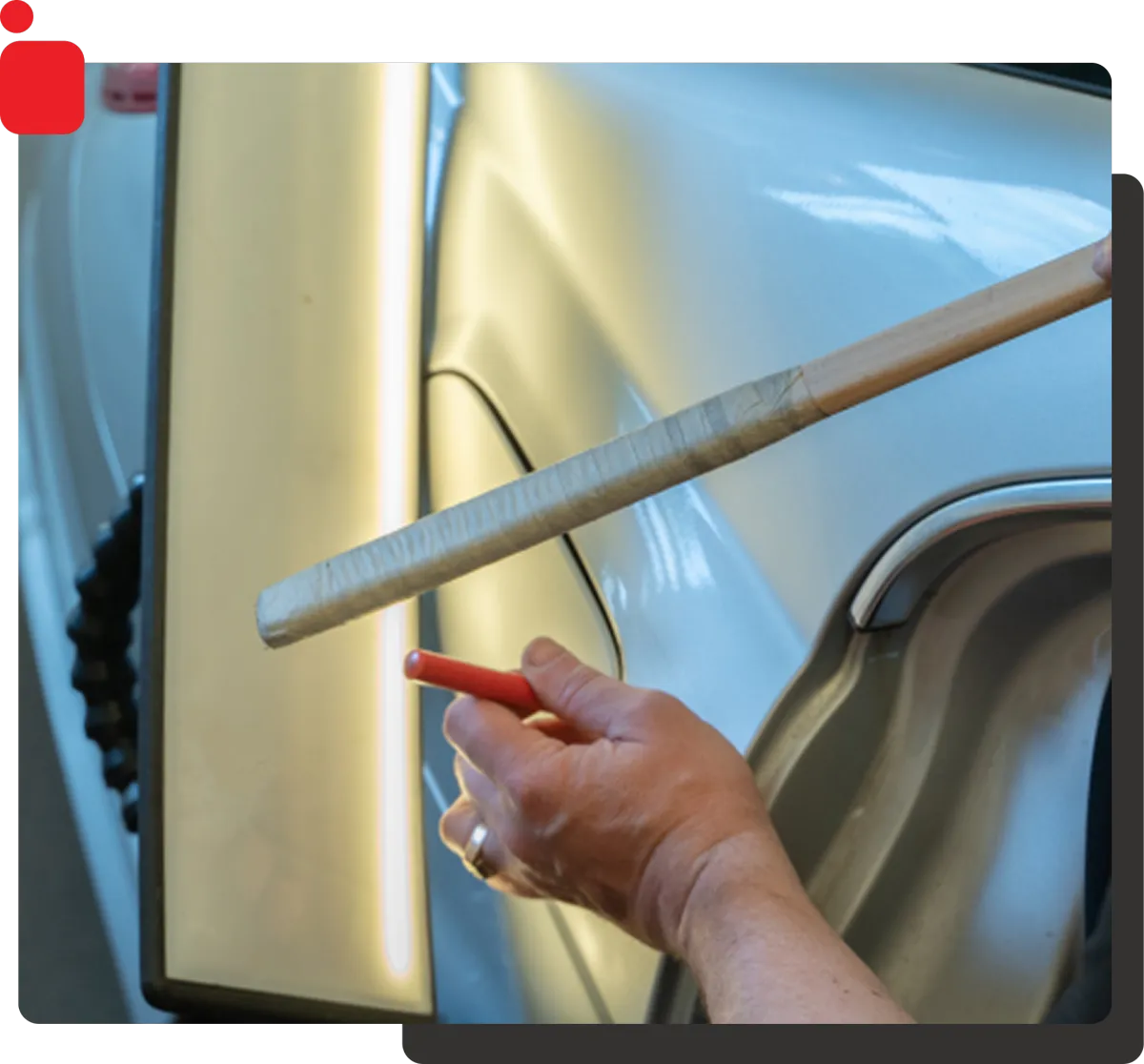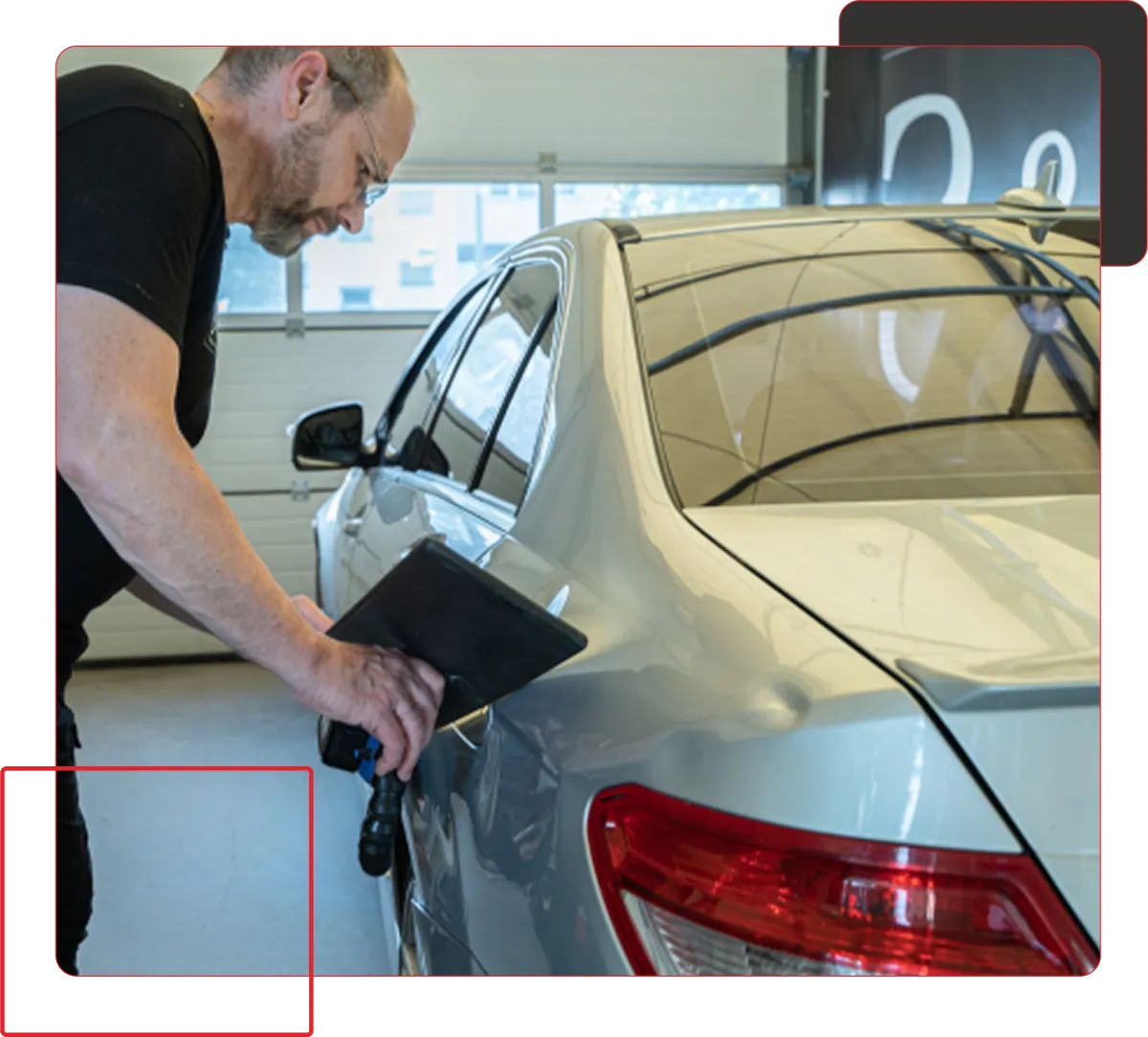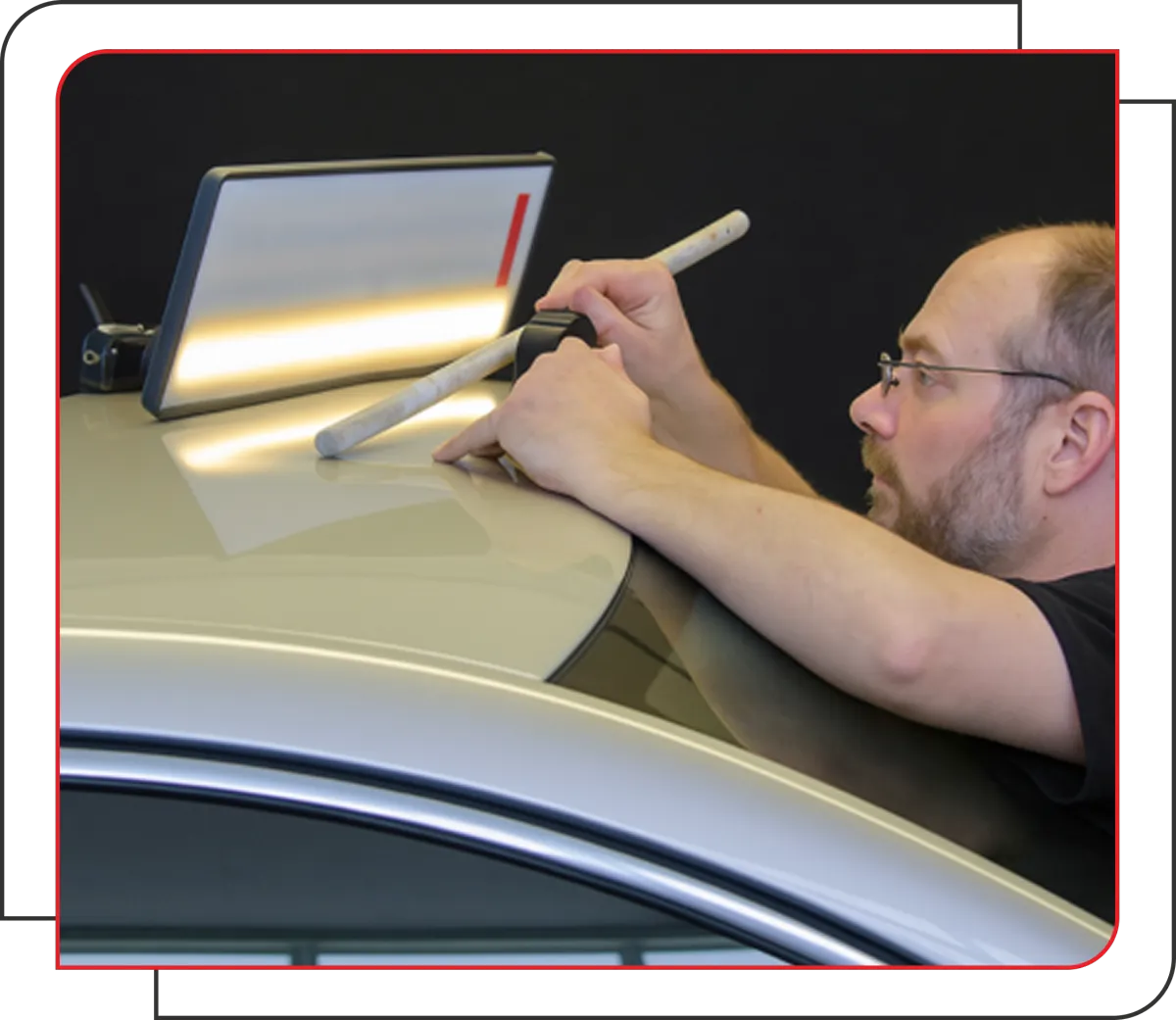Paintless Dent Repair
Expert Dent Repair Without Repainting Your Vehicle

FSDAVCFEBFEVSDDVFSD

FSDAVCFEBFEVSDDVFSD
Restore Your Vehicle to a Factory-Finish with Paintless Dent Removal

Everyday dents can happen in an instant—whether it’s a door ding in a tight parking lot, a stray shopping cart, or hail from a passing storm. While these dents may not affect how your vehicle drives, they definitely impact how it looks. That’s where paintless dent repair (PDR) makes a difference. It allows skilled technicians to remove minor dents without disturbing the original paint or replacing any panels.
We complete every dent repair in-shop using precision tools and trusted PDR techniques. This process keeps your factory finish intact while avoiding the higher costs and longer timelines of traditional bodywork. Most minor dents can be repaired quickly and at a lower cost than people expect. If your small dent has no paint damage, PDR is often the smartest way to go.

The Paintless Dent Repair Process at A+ Dent MedIC
Each repair starts with a thorough inspection by our in-shop technicians. We take the time to evaluate the dent’s depth, shape, and location, along with the condition of the surrounding paint. Not every dent qualifies for paintless repair, so we assess whether there’s any paint cracking, edge distortion, or metal stretching. If the damage is a good fit for the PDR method, we’ll explain the process clearly before starting any work. There are no surprises—just straightforward answers and clear next steps.
Once approved, the repair process begins. We access the backside of the affected panel using factory openings or by carefully removing interior trim when necessary. Specialized rods and controlled lighting help us apply precise pressure from behind the panel. The goal is to gradually push the dent out without overworking the metal. This is a skill-based technique that avoids sanding, body filler, or any damage to the paint.
When done correctly, PDR leaves the surface clean, smooth, and undetectable to the naked eye. Most repairs are completed within a few hours. There’s no repainting, no blending, and no aftermarket materials. That means your vehicle’s original finish stays intact—something that matters for appearance, resale value, and long-term durability.


PDR is the Better Alternative to Body Shop Repairs
Traditional dent repair methods rely on sanding down damaged areas, applying body filler, and then repainting the surface. While this process can work for severe damage, it’s often unnecessary for small dents and dings. It also comes with drawbacks—repainting rarely matches the factory finish perfectly, and filler can crack or shrink over time. These repairs may even show up during appraisals, which can reduce resale value.
Paintless dent repair avoids all of that. The original paint stays completely intact, and the metal is gently worked back to its original shape using specialized tools. There’s no repainting or color matching involved. For most drivers in need of door ding repair and other dent removals, PDR is the preferred option because it’s fast, affordable, and keeps the vehicle’s value intact.
Another major benefit is how clean and straightforward the process is. There are no harsh chemicals, no sanding dust, and no risk of paint blending lines. It’s a hands-on, targeted solution that works for common dents caused by hail, door dings, or parking lot bumps.
Some drivers assume they’ll have to leave their vehicle in a shop for several days—even for a single small dent. That’s rarely the case with paintless dent repair. At A+ Dent Medic, most repairs are completed in-shop on the same day, without the need for rental cars or long delays. Once we assess the size and location of the dent, we’ll let you know upfront how long the repair will take. For most minor dents, it’s just a few hours, and your vehicle will be ready to go that same day.
We’ve designed our scheduling process to keep things quick and convenient. When you bring your vehicle in, we’ll provide a straight answer, a reasonable quote, and a realistic repair window. From that point forward, the work is handled efficiently and with care. You won’t be left guessing or waiting longer than necessary. We focus on getting you back behind the wheel—with your car looking the way it should.
Recent Paintless Dent Repairs
Frequently Asked Questions Door Ding Repairs
What is paintless dent repair (PDR) for door dings?
Paintless dent repair is a method that removes small dents and dings by gently reshaping the metal from behind the panel. It avoids sanding, fillers, or repainting—preserving your car’s original finish and factory paint.
Can paintless dent repair fix all door dings?
PDR works best on dings where the paint is still intact and the dent is not on a sharp edge or severely creased. If there’s access behind the panel, most dings from doors, carts, or soft impacts can be repaired.
How long does door ding repair take?
Most door ding repairs are completed in a single day. Once we inspect your vehicle, we’ll give you an estimated timeframe based on dent size, location, and access points.
Do I need to repaint after PDR?
No. The paintless dent repair process does not involve any repainting. Our tools restore the metal without damaging your original paint, which means no color matching or blending is needed.
How much does door ding repair cost?
The cost of paintless dent repair depends on the size, location, and number of dings. After a thorough inspection, we’ll provide a clear, written estimate—no hidden fees or surprises.
Can I get a quote without bringing my car in?
Yes. You can upload photos of the damage using our online form. We’ll review the images, assess the damage, and contact you with an estimate or recommend an in-person inspection if needed.
What tools are used to fix a door ding?
We use specialized PDR tools, including rods, bars, and glue pull tabs. Depending on the dent’s location, we may access it from behind or pull it from the surface and tap it smooth.
Will PDR affect my vehicle’s resale value?
Quite the opposite—PDR helps retain resale value by keeping your factory paint intact. Because there’s no repainting, it leaves no trace of repair work on vehicle history reports.
Is PDR safe for aluminum or high-strength steel panels?
Yes. Our certified technicians are trained to work on all panel types, including aluminum. Each repair is customized based on panel material, thickness, and dent location.
How do I schedule a door ding repair at Swift PDR?
You can either stop by our shop or send us photos through our website. Once we assess the damage, we’ll explain your options, provide a quote, and book a repair time that fits your schedule.
Which Types of Dents Can Be Repaired With PDR?
Paintless dent repair is best suited for small to mid-sized dents where the paint remains intact. These dents are often caused by things like car doors, hail, or low-speed bumps in parking lots. If the dent is too deep, sharp, or includes paint cracking, PDR may not be the right solution.
Panels like doors, fenders, hoods, and roofs are common repair areas. These usually offer good access from behind the metal, which is necessary for PDR tools to reach and reshape the dented area. As long as the dent isn’t sitting on an edge or crease, chances are high that it’s repairable.
Both steel and aluminum body panels can be repaired using this technique. Aluminum may take longer due to its hardness, but it still responds well with the right tools and skill. The final result remains consistent regardless of material.


We take the evaluation process seriously. Every vehicle is carefully inspected using reflective lighting and dent-mapping boards that highlight even the smallest imperfections. These tools help us understand the depth, shape, and tension points of each dent before we begin. This allows us to develop a plan that fits the exact needs of the repair—whether it’s a single sharp door ding or a series of hail impacts across the roof. The more accurate the assessment, the better the outcome.
Our technicians don’t rely on guesswork or shortcuts. We use years of hands-on experience and a precise understanding of how different metals respond to pressure. Each dent is approached with the right tools, angles, and techniques to restore the panel smoothly and evenly. That’s why our repairs hold up over time and why the finished result blends in so well with the original finish. We take pride in doing the job right—down to the final detail.
Clean, Honest, and Cost-Effective Paintless Dent Repair
Customers often choose paintless dent repair because it’s a clean, efficient way to fix minor dents without disturbing the vehicle’s original finish. There’s no sanding, no body filler, and no repainting involved. That means fewer materials, lower labor costs, and less time spent in the shop. The repair is focused solely on reshaping the metal—leaving the surrounding area untouched. For many drivers, it’s the ideal balance between cost and quality.
Another key benefit is turnaround time. Most dents can be repaired in a matter of hours, not days. Whether you’re dealing with a single door ding or multiple hail dents, the repair process is faster than traditional methods. You won’t be left without your car for an extended period, and there’s no need to schedule a return visit for paint curing or additional blending. Quick, in-shop service means less disruption to your routine.
At A+ Dent Medic, we’re focused on helping drivers fix the damage without compromising the vehicle’s value. Our approach keeps the original paint intact, which matters during appraisals and trade-ins. You’ll leave with a clean panel, a restored surface, and peace of mind knowing the job was done right. PDR is simple, affordable, and built to last.
Frequently Asked Questions
What is paintless dent repair (PDR) and how does it work?
Paintless Dent Repair, or PDR, is a specialized technique used to remove dents and dings from a vehicle without disturbing the factory paint. It works by using precision tools—typically rods or picks—that access the backside of the damaged panel. A technician applies controlled pressure to massage the metal back to its original shape. For areas that are harder to reach, special glue tabs can be used on the exterior to gently pull the dent out. The goal is to restore the panel’s original contour without fillers, sanding, or repainting. Since there’s no need for new paint, the repair is faster, more cost-effective, and maintains the factory finish.
What types of dents can be fixed with PDR?
PDR is best suited for small to medium-sized dents where the paint has not been cracked or chipped. Common examples include door dings, hail damage, minor creases, and low-speed parking lot impacts. The ideal dent is shallow, round, and located on a flat or gently curved surface, like a door or hood panel. PDR works well on both steel and aluminum panels, though aluminum may require additional time and finesse. If the paint is intact and the dent isn’t on a sharp crease or near the edge of a panel, it’s likely a good candidate for PDR.
Are there dents that can’t be repaired with PDR?
Yes. Not all dents qualify for paintless dent repair. If the paint is cracked, chipped, or if the dent is too deep and has stretched the metal, PDR may not be the best option. Damage near reinforced edges or seams—like the lip of a door or wheel well—can be more difficult to access or reshape. Sharp creases, collision damage, or dents with prior body filler may also require traditional bodywork. That said, a trained technician can often surprise you with what can still be fixed using PDR, especially with modern tools and techniques.
How long does paintless dent repair take?
The time required depends on the size, depth, and location of the dent. Most small door dings or hail dents can be repaired in one to three hours. If your vehicle has multiple dents or panels involved—like after a hailstorm—the repair may take one to two days. Compared to body shop repairs that may take a week or more due to painting and curing times, PDR offers a much faster turnaround. At A+ Dent Medic, we’ll give you an accurate time estimate upfront, and in many cases, you’ll be back on the road the same day.
Is paintless dent repair more affordable than traditional bodywork?
Yes, paintless dent repair is generally more cost-effective than traditional repair methods. Since there’s no need for body filler, sanding, or paint, the labor and materials involved are significantly reduced. Small dents may cost as little as $175–$300, while larger or more complex dents may range higher. Traditional repairs often involve multiple steps and higher parts and labor costs—sometimes totaling several hundred dollars for even minor damage. Plus, PDR helps you avoid hidden costs like paint mismatch or diminished resale value due to panel replacements.
Will PDR affect my car’s factory paint or finish?
No. One of the biggest advantages of paintless dent repair is that it preserves your vehicle’s original factory finish. The tools used in PDR apply pressure behind the panel rather than disturbing the exterior surface. Since no paint, filler, or sanding is involved, there’s no risk of mismatched paint, overspray, or paint shrinkage over time. This helps retain your car’s resale value and ensures the repaired area blends in flawlessly with the rest of the vehicle.
Is paintless dent repair a permanent fix?
Yes. When done correctly by a trained technician, PDR is a permanent solution. The dented metal is reshaped to its original form, and it will not “pop” back in the future. There’s no chance of the damage returning unless the panel is hit again. The repair won’t degrade or change over time like some filler-based repairs might. A+ Dent Medic uses industry-grade tools and processes to ensure lasting results with no shortcuts.
Does insurance cover paintless dent repair?
In many cases, yes. Most comprehensive auto insurance policies cover paintless dent repair—especially for hail damage. Since PDR is typically less expensive and preserves the vehicle’s value better than conventional repairs, many insurance companies prefer it. If you're filing a claim, you’ll usually just need a damage inspection and estimate, which A+ Dent Medic can provide. We also work directly with insurance adjusters to make the process as smooth as possible, ensuring your claim moves forward quickly.
Will a PDR repair show up on a Carfax or vehicle history report?
Typically, no. Because paintless dent repair doesn’t involve panel replacements, paintwork, or collision repairs, it generally doesn’t get reported to Carfax or other vehicle history services. That’s a major benefit for resale value—your car’s report stays clean, which can help you retain more of its value when trading in or selling. However, if the repair was filed under an insurance claim, the incident itself may still be noted depending on the insurer’s reporting policies.
Is it better to use a professional than a DIY dent repair kit?
Yes, using a professional is highly recommended. While DIY dent repair kits may seem convenient and inexpensive, they come with significant risk. Without the right tools and experience, it’s easy to crack the paint, over-pull the dent, or cause rippling in the metal. These mistakes often result in more expensive repairs down the road. A+ Dent Medic technicians are trained to evaluate dent depth, panel material, and tool access, delivering precise results that a DIY kit simply can’t match.
Contact Info
Service Hours
Social Media
Mon-Thur: 8:00 am – 5:00 pm
Friday: Appointment Only
Sat-Sun: Closed
Home
Services
Service Areas
Blog
About
Contact
Contact Info
Service Hours
Mon-Thur: 8:00 am – 5:00 pm
Friday: Appointment Only
Sat-Sun: Closed
Social Media

Licensed & Insured
